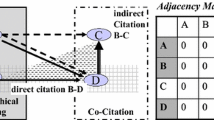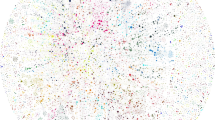Abstract
In this paper, we explore the longitudinal research collaboration network of ‘mammography performance’ over 30 years by creating and analysing a large collaboration network data using Scopus. The study of social networks using longitudinal data may provide new insights into how this collaborative research evolve over time as well as what type of actors influence the whole network in time. The methods and findings presented in this work aim to assist identifying key actors in other research collaboration networks. In doing so, we apply a rank aggregation technique to centrality measures in order to derive a single ranking of influential actors. We argue that there is a strong correlation between the level of degree and closeness centralities of an actor and its influence in the research collaboration network (at macro/country level).






Similar content being viewed by others
References
Abbasi, A., Altmann, J., & Hossain, L. (2011a). Identifying the effects of co-authorship networks on the performance of scholars: A correlation and regression analysis of performance measures and social network analysis measures. Journal of Informetrics, 5, 594–607.
Abbasi, A., Hossain, L., Uddin, S., et al. (2011b). Evolutionary dynamics of scientific collaboration networks: Multi-levels and cross-time analysis. Scientometrics, 89, 687–710.
Abbasi, A., & Kapucu, N. (2012). Structural dynamics of organizations during the evolution of interorganizational networks in disaster response. Journal of Homeland Security and Emergency Management, 9(1).
Barabási, A.-L., Jeong, H., Néda, Z., et al. (2002). Evolution of the social network of scientific collaborations. Physica A: Statistical Mechanics and its Applications, 311, 590–614.
Bian, J., Xie, M., Topaloglu, U., Hudson, T., Eswaran, H., & Hogan, W. (2014). Social network analysis of biomedical research collaboration networks in a CTSA institution. Journal of biomedical informatics, 52, 130–140.
Borgatti, S. P. (1995). Centrality and AIDS. Connections, 18, 112–114.
Borgatti, S. P. (2005). Centrality and network flow. Social Networks, 27, 55–71.
Borgatti, S. P., Everett, M. G., & Freeman, L. C. (2002). Ucinet 6 for Windows: Software for social network analysis. Harvard, MA: Analytic Technologies.
Cassi, L., Morrison, A., & Ter Wal, A. L. (2012). The evolution of trade and scientific collaboration networks in the global wine sector: A longitudinal study using network analysis. Economic Geography, 88, 311–334.
Chen, Y.-H., & Yu, C.-C. (2001). Dynamical properties of product life cycles: Implications to the design and operation of industrial processes. Industrial and Engineering Chemistry Research, 40, 2452–2459.
Coleman, J. S. (1989). Social capital in the creation of human capital. Chicago: University of Chicago Press.
Freeman, L. C. (1977). A set of measures of centrality based on betweenness. Sociometry, 35–41.
Freeman, L. C. (1979). Centrality in social networks conceptual clarification. Social Networks, 1, 215–239.
Goh, K. I., Oh, E., Kahng, B., et al. (2003). Betweenness centrality correlation in social networks. Physical Review E, 67, 017101.
Hossain, L., Atkinson, S. R., & Uddin, S. (2012). New directions in the analysis of social network dynamics. KDIR 2012—Proceedings of the International Conference on Knowledge Discovery and Information Retrieval. 269–274.
Jarrett, J., & Clarkson, P. J. (2002). The surge-stagnate model for complex design. Journal of Engineering Design, 13, 189–196.
Jiang, Y. (2008). Locating active actors in the scientific collaboration communities based on interaction topology analyses. Scientometrics, 74, 471–482.
Jiang, Y., & Jiang, J. C. (2014). Understanding social networks from a multiagent perspective. IEEE Transactions on Parallel and Distributed Systems, 25, 2743–2759.
Katz, J. S., & Martin, B. R. (1997). What is research collaboration? Research Policy, 26, 1–18.
Kempe, D., Kleinberg, J., & Tardos, É. (2003). Maximizing the spread of influence through a social network. Proceedings of the ninth ACM SIGKDD international conference on Knowledge discovery and data mining. ACM, 137–146.
Kim, S., & Shin, E.-H. (2002). A longitudinal analysis of globalization and regionalization in international trade: A social network approach. Social Forces, 81, 445–468.
Liben-Nowell, D., & Kleinberg, J. (2007). The link-prediction problem for social networks. Journal of the American Society for Information Science and Technology, 58, 1019–1031.
Luukkonen, T., Tijssen, R. J., Persson, O., et al. (1993). The measurement of international scientific collaboration. Scientometrics, 28, 15–36.
McPherson, M., Smith-Lovin, L., & Cook, J. M. (2001). Birds of a feather: Homophily in social networks. Annual Review of Sociology, 415–444.
Melin, G. (2000). Pragmatism and self-organization: Research collaboration on the individual level. Research Policy, 29, 31–40.
Modis, T. (1994). Fractal aspects of natural growth. Technological Forecasting and Social Change, 47, 63–73.
Newman, M. E. (2001). The structure of scientific collaboration networks. Proceedings of the National Academy of Sciences, 98, 404–409.
Newman, M. E. (2004). Coauthorship networks and patterns of scientific collaboration. Proceedings of the National Academy of Sciences, 101, 5200–5205.
Newman, M. E. (2005). A measure of betweenness centrality based on random walks. Social Networks, 27, 39–54.
Owen-Smith, J., Riccaboni, M., Pammolli, F., et al. (2002). A comparison of US and European university–industry relations in the life sciences. Management Science, 48, 24–43.
R Core Team. (2013). R: A language and environment for statistical computing. Vienna, Austria: R Foundation for Statistical Computing.
Reay Atkinson, S., (2010). Returning science to the social. The Shrivenham Papers, UK Defence Academy Number 10, July.
Scott, J. (1991). Social network analysis: A handbook. Sage.
Snijders, T. A., Van de Bunt, G. G., & Steglich, C. E. (2010). Introduction to stochastic actor-based models for network dynamics. Social Networks, 32, 44–60.
Sonnenwald, D. H. (2007). Scientific collaboration. Annual review of Information Science and Technology, 41, 643–681.
Tavakoli Taba, S., & Mirkarimi, S. (2014). CRRCN: A social network application program for extracting co-authorship relations in research collaboration networks University of Sydney.
Uddin, S., Hossain, L., Abbasi, A., et al. (2012). Trend and efficiency analysis of co-authorship network. Scientometrics, 90, 687–699.
Wagner, C. S., & Leydesdorff, L. (2005). Network structure, self-organization, and the growth of international collaboration in science. Research Policy, 34, 1608–1618.
Wang, D., Pedreschi, D., & Song, C., et al. (2011). Human mobility, social ties, and link prediction. Proceedings of the 17th ACM SIGKDD international conference on Knowledge discovery and data mining. ACM, 1100–1108.
Wasserman, S. (1994). Social network analysis: Methods and applications. Cambridge: Cambridge University Press.
Author information
Authors and Affiliations
Corresponding author
Rights and permissions
About this article
Cite this article
Tavakoli Taba, S., Hossain, L., Reay Atkinson, S. et al. Towards understanding longitudinal collaboration networks: a case of mammography performance research. Scientometrics 103, 531–544 (2015). https://doi.org/10.1007/s11192-015-1560-3
Received:
Published:
Issue Date:
DOI: https://doi.org/10.1007/s11192-015-1560-3




